List of churches preserved by the Churches Conservation Trust in Southeast England
The Churches Conservation Trust, which was initially known as the Redundant Churches Fund, is a charity whose purpose is to protect historic churches at risk, those that have been made redundant by the Church of England. The Trust was established by the Pastoral Measure of 1968.[1] The legally defined object of the Trust is "the preservation, in the interests of the nation and the Church of England, of churches and parts of churches of historic and archaeological interest or architectural quality vested in the Fund ... together with their contents so vested".[2] The charity cares for over 350 churches.[1] The Trust is financed partly by the Department for Culture, Media and Sport and the Church Commissioners, but grants from those bodies were frozen in 2001, since when additional funding has come from other sources, including the general public. In the 12 months ending 31 March 2010 the charity's income was £6,161,653, and its spending was £6,035,871. During that year it had 44 employees, and used the services of 2,000 volunteers.[3] The charity is run by a board of trustees, who delegate the day-to-day management to a chief executive and his senior management team.[4]
The Trust's primary aim is to ensure that the buildings in its care are weatherproof and to prevent any deterioration in their condition. The majority of the churches remain consecrated, and many are occasionally still used for worship. Local communities are encouraged to use them for appropriate activities and events, and the buildings provide an educational resource, allowing children and young people to study history and architecture. Nearly 2 million people visit the Trust's churches each year.[1] As most of the churches remain consecrated, they are used for occasional services where this is practical, and some are venues for concerts and other purposes.
This list contains the 56 churches preserved by the Churches Conservation Trust in Southeast England, consisting of those in the counties of Oxfordshire, Buckinghamshire, Greater London, Berkshire, Hampshire, Surrey, Kent, West Sussex, and East Sussex. The churches range in age from the Anglo-Saxon All Saints Church, West Stourmouth, to the newest church in the list, Holy Trinity Church, Privett, which was built between 1876 and 1878. All the churches are designated by English Heritage as listed buildings, most of them in Grades I and II*.
Key
| Grade | Criteria[5] |
|---|---|
| I | Buildings of exceptional interest, sometimes considered to be internationally important |
| II* | Particularly important buildings of more than special interest |
| II | Buildings of national importance and special interest |
Churches
| Name and town or village |
County and coordinates |
Photograph | Date[A] | Notes | Grade |
|---|---|---|---|---|---|
| St Botolph Botolphs |
West Sussex 50°52′20″N 0°18′22″W / 50.8722°N 0.3062°W |
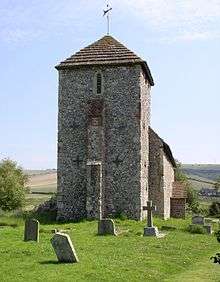 |
Anglo-Saxon | The nave and chancel are Saxon, and the south doorway dates from the 17th century. A north aisle was added in about 1250, but this was demolished in the early 19th century. Around the chancel arch are traces of medieval wall paintings.[6][7] | I |
| All Saints West Stourmouth |
Kent 51°19′13″N 1°14′11″E / 51.3203°N 1.2365°E |
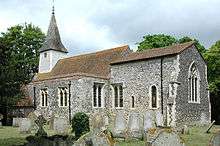 |
Anglo-Saxon | The oldest fabric in the church is Anglo-Saxon. The church was altered in the 12th century, but following earthquake damage in 1382 it was rebuilt. Windows were replaced in the 14th and 15th centuries, and the church was restored in 1845. It has been redundant since 1979. The base of a rood screen is still present inside the church.[8][9] | I |
| St Peter and St Paul (old) Albury |
Surrey 51°13′12″N 0°28′44″W / 51.2200°N 0.4790°W |
 |
11th century | The nave may date from the Anglo-Saxon era, and the lower part of the tower contains pre-Conquest masonry. The nave was extended in the 12th century, the chancel and south transept were added in the 13th century, followed by the south aisle in the following century. During the 19th century the Albury Park estate, in which the church stands, was owned by the banker Henry Drummond. He replaced the spire on the tower with a cupola, and commissioned A. W. N. Pugin to convert the south transept into a mortuary chapel.[10][11] | I |
| St Thomas East Shefford |
Berkshire 51°28′11″N 1°26′21″W / 51.4698°N 1.4391°W |
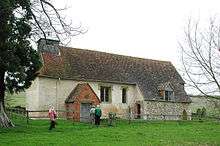 |
11th century | Norman features in the church include a north window, the font, and a piscina. Also in the church is the alabaster tomb of Sir Thomas Fettiplace, who died in 1447, and his wife, Lady Beatrice, who was a member of the Portuguese royal family. On the walls above the chancel arch are 12th-century paintings and painted texts. Worship ceased in the church in 1870, and its congregation transferred to a new church nearby.[13][14][15][16] | I |
| St Mary Higham |
Kent 51°26′27″N 0°28′06″E / 51.4409°N 0.4683°E |
 |
11th century | The church is constructed in flint and ragstone, the flint arranged to give the appearance of horizontal stripes. The south aisle is almost as wide as the nave, and it is thought that this was added in the 14th century by a nunnery sited nearby at that time. The font is Norman, and between the nave and the Lady chapel is a 15th-century rood screen.[17][18][19] | I |
| All Saints Little Somborne |
Hampshire 51°05′31″N 1°27′21″W / 51.0919°N 1.4557°W |
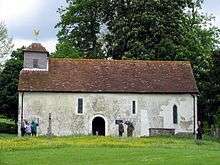 |
11th century | All Saints has a simple plan, consisting of a nave and a chancel in a single range. The church incorporates an Anglo-Saxon pilaster strip and a Norman round-headed doorway. In the churchyard is the grave of Thomas Sopwith, the pioneer aviator.[20][21][22] | II* |
| St Mary the Virgin North Stoke |
West Sussex 50°53′15″N 0°33′05″W / 50.8874°N 0.5514°W |
11th century | The ancient dedication of the church to Saint Mary the Virgin was rediscovered in 2007 by two amateur archaeologists. The church has a cruciform plan with a nave, chancel and two transepts. It contains windows in six different architectural styles. The oldest fitting is a 13th-century font.[23][24][25][26][27] | I | |
| St Mary Sandwich |
Kent 51°16′38″N 1°20′19″E / 51.2772°N 1.3387°E |
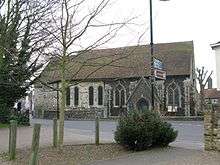 |
11th century | St Mary's has suffered from repeated damage: by the French in 1217 and again in 1457, and from an earthquake in 1578. In 1667 the central tower collapsed, and was rebuilt. In the 19th century the church was restored by Joseph Clarke. Since being made redundant it has been used as an arts centre.[28][29][30][31] | I |
| All Saints Shirburn |
Oxfordshire 51°39′28″N 0°59′41″W / 51.6577°N 0.9946°W |
_All_Saints_Church_-_geograph.org.uk_-_69744.jpg) |
11th–12th century | All Saints stands immediately to the south of Shirburn Castle, the seat of the Earls of Macclesfield. Its north chapel is the mausoleum of the Macclesfield family. The church was restored and largely rebuilt in 1876 by T. H. Wyatt.[32][33] | II |
| St Mary Ashley |
Hampshire 51°04′34″N 1°27′07″W / 51.0762°N 1.4519°W |
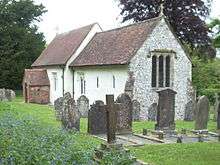 |
Early 12th century | The chancel was added later in the 12th century, and the windows date from the 15th and 16th centuries. The church was restored twice in the 19th century. Inside the church is a Norman font. There is a painting of a saint in the splay of one of the windows.[34][35] | II* |
| St Benedict Paddlesworth |
Kent 51°20′00″N 0°25′01″E / 51.3332°N 0.4170°E |
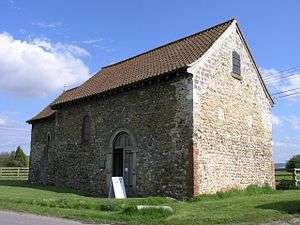 |
Early 12th century | This simple church stands on the Pilgrims' Way. It closed as a church in 1678 and was then used for some 250 years for non-religious purposes, including use as a farm building. A gallery was added in the 19th century, and the church was restored twice during the 20th century.[36][37] | II* |
| St Mary Burham |
Kent 51°19′53″N 0°27′45″E / 51.3313°N 0.4626°E |
 |
12th century | Standing on the Pilgrims' Way, this church served a now-deserted village. Its north and south aisles have been demolished. Inside the church are two Norman fonts.[38][39] | I |
| St Mary Capel-le-Ferne |
Kent 51°06′54″N 1°13′25″E / 51.1150°N 1.2235°E |
 |
12th century | St Mary's stands in an isolated position. A stone chancel arch was added in the 14th century containing a three-bay arcade. Above the arcade is a large round-headed opening that silhouetted the rood cross, a feature unique in England. The church also contains a memorial to General Sir Charles William Dunbar Staveley, who died in 1896.[40][41] | I |
| St Margaret Catmore |
Berkshire 51°31′07″N 1°20′50″W / 51.5186°N 1.3472°W |
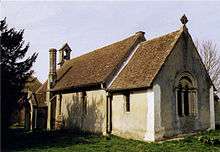 |
12th century | The Norman features in this church include two doorways and the font. The nave roof dates from 1607. During the 19th century the church was restored and Norman Revival features were added, which were more ornate than the original Norman features.[42][43][44] | I |
| Lumley Chapel Cheam |
Greater London 51°21′38″N 0°12′58″W / 51.3606°N 0.2161°W |
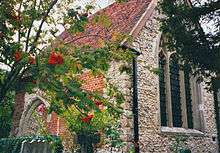 |
12th century | The chapel consists of the east end of the chancel of a former church that had been converted into a memorial chapel for the Lumley family of nearby Nonsuch Palace. It contains memorials to the Lumleys and to other families. The chapel is the oldest standing building in the London Borough of Sutton.[45][46][47][48] | II* |
| St Peter ad Vincula Colemore |
Hampshire 51°04′19″N 0°59′37″W / 51.0719°N 0.9937°W |
 |
12th century | The plan of this church was formerly cruciform, but in 1669 the parishioners considered that the interior was too dark, and they successfully petitioned the bishop for the south transept to be removed. The remaining north transept has a 12th-century doorway in its west wall, a 12th-century window in the north wall, and an 11th-century window in the east wall. Inside the church are a 12th-century font made from Purbeck Marble and a 16th-century wooden screen.[49][50] | II* |
| St Michael East Peckham |
Kent 51°14′40″N 0°22′45″E / 51.2445°N 0.3792°E |
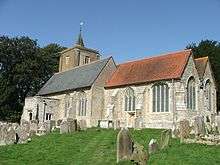 |
12th century | St Michael's expanded to its present size in about 1300, and it was restored in the 19th century by Joseph Clarke. It contains one Norman window. Elsewhere there are Perpendicular-style windows that were renewed during the restoration.[52][53] | II* |
| St Mary Fleet Marston |
Buckinghamshire 51°50′13″N 0°52′11″W / 51.8369°N 0.8697°W |
— |
12th century | Set in an isolated position surrounded by fields, the church was restored by George Gilbert Scott in 1868. John Wesley preached a sermon here soon after his ordination in 1725. The fittings of the church include a Norman font.[54][55] | II* |
| St Mary the Virgin Fordwich |
Kent 51°17′45″N 1°07′38″E / 51.2958°N 1.1271°E |
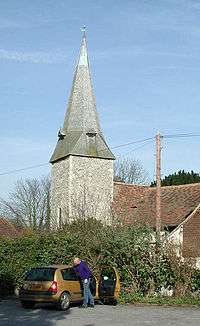 |
12th century | Dating mainly from the Norman era, the church incorporates some Saxon material in the nave. Inside the church are box pews, and a civic pew containing a stand to hold the mayor's mace. Also in the church is the Fordwich stone, dating from about 1100 and considered to be part of the former shrine of a saint.[57][58][59] | I |
| St Bartholomew Goodnestone |
Kent 51°19′00″N 0°55′56″E / 51.3166°N 0.9322°E |
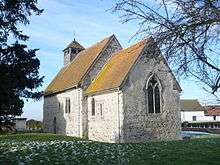 |
12th century | The plan of this flint church is simple, consisting of a nave with a north porch, and a chancel. The porch was rebuilt in 1837 after it had been damaged by an earth tremor. The stained glass in the east window is by Thomas Willement.[60][61] | I |
| St Mary Luddenham |
Kent 51°19′57″N 0°51′31″E / 51.3324°N 0.8586°E |
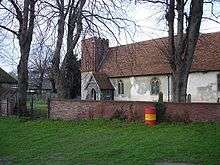 |
12th century | This flint church stands in a farmyard, and its structure incorporates some re-used Roman tiles. The west door is Norman, and is decorated with zigzags. Inside the church is a 13th-century coffin lid carved with hands holding a heart.[62][63] | I |
| St John the Baptist Mongewell |
Oxfordshire 51°35′10″N 1°07′24″W / 51.5861°N 1.1233°W |
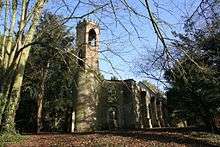 |
12th century | Partly ruined, the church stands to the north of Mongewell Park, near The Ridgeway long-distance path. It was remodelled in picturesque Gothic style in the late 18th century for Rev Shute Barrington, Bishop of Durham. The structure consists of a roofless nave, a roofed chancel, and a west tower.[64][65] | II |
| St Mary Newnham Murren |
Oxfordshire 51°35′31″N 1°07′13″W / 51.5919°N 1.1203°W |
 |
12th century | St Mary's is at the end of a farm track, overlooking the River Thames. The doorway and chancel arch are both Norman. In 1849 the church was restored and most of the fittings were removed, although a Jacobean pulpit and communion table are still present.[66][67] | II* |
| St Mary (old) Preston Candover |
Hampshire 51°10′07″N 1°08′17″W / 51.1687°N 1.1380°W |
_-_geograph.org.uk_-_377290.jpg) |
12th century | Only the chancel of the church remains. The church was damaged in a fire in 1681 and rebuilt, then enlarged in 1831. However, by 1885 its fabric had deteriorated so much that, except for the chancel, it was demolished, and a new church with the same dedication was built nearer the centre of the village.[68][69] | II* |
| St Mary Magdalene Tortington |
West Sussex 50°50′09″N 0°34′37″W / 50.8357°N 0.5769°W |
 |
12th century | Both the doorway and the chancel arch are Norman in style, and are decorated with elaborate carvings. The font dates from the 12th century, and some of the windows contain stained glass from the Kempe studio.[70][71] | II |
| All Saints Waldershare |
Kent 51°11′15″N 1°17′09″E / 51.1875°N 1.2858°E |
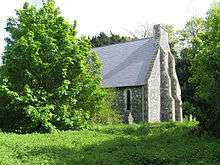 |
12th century | Mortuary chapels were added to the church in about 1697 and in about 1712, and the main part of the church was restored and virtually rebuilt in 1886 by Ewan Christian. The chapels contain large and elaborate memorials. Also in the church are wall paintings by Clayton and Bell dating from about 1886. The North Downs Way passes through the churchyard.[72][73][74] | II* |
| St John the Baptist Upper Eldon |
Hampshire 51°02′54″N 1°28′54″W / 51.0483°N 1.4816°W |
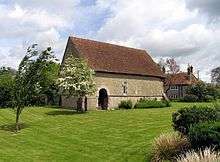 |
Late 12th century | Despite repairs in the 18th century, the condition of the building was so bad by the following century that it was being used as a cowshed. Since being vested in the Trust, further repairs have been undertaken. Around the church are nine consecration cross stones, each consisting of a circle in which there are five holes that formerly held metal crosses.[75][76][77] | II* |
| St Andrew (Old) Kingsbury |
Greater London 51°34′05″N 0°15′42″W / 51.5680°N 0.2618°W |
 |
12th-13th century | The condition of this church had deteriorated towards the end of the 18th century. A major restoration was carried out in 1840, and it became a chapel of ease to a church in another part of the parish. In 1933 a new church, also dedicated to Saint Andrew, was moved from the Marylebone area of London and erected adjacent to the older church.[78][79][80] | I |
| St Giles' Merston |
West Sussex 50°48′58″N 0°43′58″W / 50.8162°N 0.7328°W |
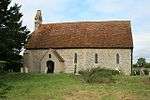 |
Early 13th century | The church is small and simple, consisting of a nave and chancel without any division, a narrow north aisle, and a south porch. It has a deep sweeping roof, and a bellcote on the west gable.[81][82][83] | I |
| St Thomas à Becket Capel |
Kent 51°10′35″N 0°20′28″E / 51.1764°N 0.3410°E |
 |
13th century | The tower of the church had to be partly rebuilt following a fire in 1639. Wall paintings depicting biblical scenes, probably dating from the 13th century, were rediscovered in 1967. It is said that Thomas à Becket preached either in the church, or under a yew tree in the churchyard.[84][85][86] | I |
| St Wilfrid Church Norton, Selsey |
West Sussex 50°45′18″N 0°45′55″W / 50.7549°N 0.7652°W |
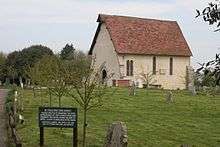 |
13th century | Now known as St Wilfrid's Chapel, it consists of the 13th-century chancel of a former church. In 1865 the rest of the church was demolished, and the material was used in the construction of a larger church in the centre of the village. It contains a large monument dating from 1537 flanked by carvings depicting Saint George and the martyrdom of Saint Agnes. Also in the chapel is modern stained glass, including a window by Michael Farrar-Bell.[87][88] | I |
| St James Cooling |
Kent 51°27′19″N 0°31′35″E / 51.4553°N 0.5264°E |
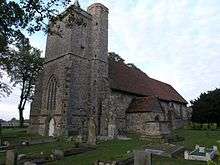 |
13th century | Building of the church was complete by about 1400. It was restored in the 19th century, when a vestry was added, and the porch was rebuilt. The interior of the vestry is completely lined with cockle shells, the emblem of Saint James.[89][90][91] | I |
| St Mary Edlesborough |
Buckinghamshire 51°51′42″N 0°35′34″W / 51.8617°N 0.5927°W |
 |
13th century | Standing in an elevated position, this church with its limestone tower is a local landmark. It was restored following a fire in 1828. Its contents include medieval wooden carvings on a complete chancel screen, misericords, and a four-tier tester. Some of the walls are decorated with 19th-century paintings.[92][93] | I |
| St Nicholas Freefolk |
Hampshire 51°14′05″N 1°18′12″W / 51.2346°N 1.3033°W |
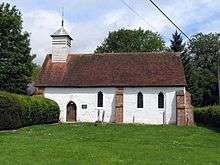 |
13th century | The church consists of a single rectangular cell. It has a weatherboarded bellcote with a pyramidal roof. The walls are partly rendered, and are supported by brick buttresses. The windows are Perpendicular in style. The contents of the church include a large Jacobean monument, two hatchments, a Royal arms dated 1701, and a Victorian font.[94][95] | I |
| St Mary Hartley Wintney |
Hampshire 51°17′48″N 0°54′01″W / 51.2968°N 0.9002°W |
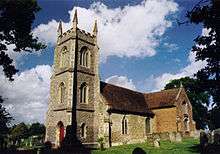 |
13th century | When the nuns of Wintney Priory built the church it consisted of a nave and a chancel. The transepts and the tower were added in the middle of the 19th century. When its functions were replaced by a new parish church, it became a mortuary chapel. On its walls are the remains of 13th-century wall paintings, including one depicting Saint Christopher.[96][97][98] | II* |
| St Mary Pitstone |
Buckinghamshire 51°49′30″N 0°38′03″W / 51.8251°N 0.6342°W |
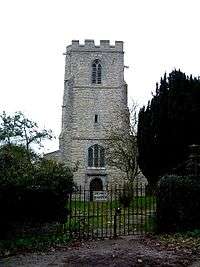 |
13th century | St Mary's is constructed in limestone and flint. It has a three-stage tower with a stair turret, and an embattled parapet. The axis of the chancel is inclined to the north. In the church are a stoup, a squint, a piscina with a crocketted gable, a 12th-century font, and a 17th-century hexagonal pulpit with a sounding board.[99][100][101] | I |
| St Peter Preston Park |
East Sussex 50°50′32″N 0°08′58″W / 50.8423°N 0.1495°W |
 |
13th century | This church stands in the grounds of Preston Manor. The nave was restored in 1872 by James Woodman when the south vestry was added. The chancel was restored in 1878 by Ewan Christian; this included stencil decoration of the walls. The nave was damaged by fire in 1906, and restored by P. M. Johnston. The fire damaged the 14th-century wall paintings, but fragments remain depicting, among other subjects, the martyrdom of Thomas à Becket and The Nativity.[102][103] | II* |
| St Peter Sandwich |
Kent 51°16′30″N 1°20′25″E / 51.2749°N 1.3403°E |
 |
13th century | In 1560 St Peter's became the church for a group of Dutch Protestants. The tower collapsed in 1661, destroying the south aisle. The tower was rebuilt, but the south aisle was left ruined and the south arcade was filled in. A cupola was added to the top of the tower. In the 1860s the west end was restored after it was damaged in a storm. Under the chancel is a vaulted undercroft lit by two 13th-century openings, which was probably used as a charnel house.[104][105][106] | I |
| St Peter Swingfield |
Kent 51°08′47″N 1°11′28″E / 51.1465°N 1.1910°E |
 |
13th century | The 13th-century square tower has a circular southwest stair turret rising higher than the tower. The church was close associations with the Knights Hospitallers. The body of the church dates mainly from the 14th century, and was restored in 1870. Some of the stained glass dates from the 20th century.[107][108] | I |
| Holy Sepulchre Warminghurst |
West Sussex 50°56′25″N 0°24′41″W / 50.9403°N 0.4114°W |
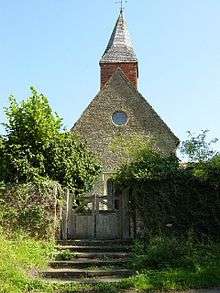 |
13th century | The plan of this sandstone church is simple, consisting of a nave and chancel in one cell, with a north chapel now used as a vestry. At the west end is a bell turret with a broach spire. It was restored in the early 18th century when a timber screen was inserted between the nave and chancel. This contains three arches, above which is a tympanum elaborately painted with the royal arms of Queen Anne. Most of the other fittings also date from this restoration.[109][110][111] | I |
| St Bartholomew Lower Basildon |
Berkshire 51°30′33″N 1°07′12″W / 51.5091°N 1.1201°W |
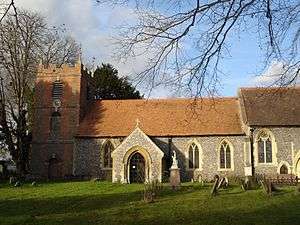 |
Late 13th century | The tower was built in 1734, and during a restoration in 1875–76 the porch and north aisle were added. Inside the church are a number of memorials, including one to Sir Francis Sykes, who died in 1804, by John Flaxman. The agricultural reformer Jethro Tull was christened and buried in the church.[112][113] | I |
| St Lawrence Broughton |
Buckinghamshire 52°03′08″N 0°41′52″W / 52.0522°N 0.6979°W |
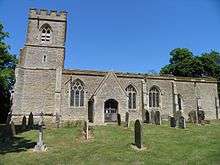 |
14th century | The church is notable for its wall paintings dating from about 1400. When they were rediscovered during a restoration in 1849 they had been covered in plaster for 300 years. The paintings were restored in the 1930s and depict, among other subjects, Saint George and the dragon, and Saints Helena and Eligius. There is also a doom painting and a Pietà; these were intended to be a warning against swearing. The stained glass includes windows designed by A. Gibbs and C. E. Kempe.[114][115] | I |
| St Michael Thornton |
Buckinghamshire 52°01′10″N 0°54′19″W / 52.0194°N 0.9054°W |
— |
14th century | The plan of the church consists of a nave with north and south aisles. The chancel and a north chapel were demolished between 1780 and 1800 when the church was reordered. The aisles contain box pews, including a larger one for the lord of the manor. There is no seating in the nave, which is occupied by a series of memorials. One of these is a re-assembled tomb chest that had been moved out of the church in the 19th century and used to form a grotto.[116][117][118][119] | I |
| St Clement Knowlton |
Kent 51°14′02″N 1°16′01″E / 51.2338°N 1.2669°E |
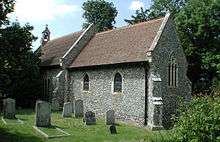 |
14th–15th century | Originally the private chapel to Knowlton Court, it later became a parish church. It contains monuments to members of the families who lived in Knowlton Court, including the Peyton Baronets. Other memorials are one to Sir John Narborough, who died in 1688, and another to his sons, John and James, who together with Cloudesley Shovell died in a shipwreck off the Scilly Islands in 1707. The latter memorial has been attributed to Grinling Gibbons.[120][121] | I |
| St George Esher |
Surrey 51°22′09″N 0°21′52″W / 51.3693°N 0.3645°W |
1540 | Built shortly after the Reformation, this church is in Tudor style. In 1725 an extension was added to the south of the nave known as the Newcastle Pew. This was designed as a family pew by Sir John Vanbrugh for the 1st Duke of Newcastle. At its front, overlooking the nave, is a row of Corinthian columns surmounted by a pediment. The church also contains a three-decker pulpit with a tester.[122][123][124] | I | |
| Chandos Mausoleum Little Stanmore |
Greater London 51°36′30″N 0°17′22″W / 51.6083°N 0.2894°W |
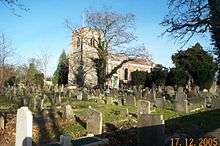 |
1735 | The mausoleum was added to the north side of the church of St Lawrence Whitchurch for the 1st Duke of Chandos in 1735. It was designed by James Gibbs, and contains memorials to members of the Chandos family. The church itself continues to be in active use, and the mausoleum is vested in the Trust.[125][126][127] | I |
| St Mary Hartwell |
Buckinghamshire 51°48′19″N 0°50′55″W / 51.8052°N 0.8486°W |
1753–55 | An early example of Gothic Revival architecture, St Mary's was intended to be a feature in the grounds of Hartwell House. Its plan is octagonal, with towers at the east and west ends. By the time it was vested in the Trust, it was a roofless ruin. The Trust has carried out repairs, including rebuilding the roof in its original design using Westmorland slate.[128][129][130] | II* | |
| St Katherine Chiselhampton |
Oxfordshire 51°41′19″N 1°08′41″W / 51.6887°N 1.1447°W |
 |
1762 | St Katherine's is a Georgian church with rendered walls and limestone dressings. At the west end is a two-stage turret, the lower stage containing a clock, and the upper stage being open. Other than the 17th-century pulpit, all the fittings date from the 18th century. When the church was threatened with demolition in the 1950s, its survival was supported by Sir John Betjeman who wrote a verse relating to it.[131][132] | II* |
| St Peter Wallingford |
Oxfordshire 51°36′03″N 1°07′18″W / 51.6007°N 1.1217°W |
1763 | The spire, designed by Sir Robert Taylor, was added in 1776–77, and the chancel was built in 1904. The nave and tower are in Neoclassical style, and the chancel is Gothic Revival. The church hosts a series of chamber music concerts each summer.[133][134][135] | II* | |
| All Saints (old) Nuneham Courtenay |
Oxfordshire 51°40′50″N 1°13′06″W / 51.6805°N 1.2182°W |
_church%2C_Nuneham_Courtenay_-_geograph.org.uk_-_716432.jpg) |
1764 | Replacing an earlier church on its site in the grounds of Nuneham House, it was designed by the owner of the house, the 1st Earl Harcourt, with alterations made by the architect James Stuart. It is in Neoclassical style, its design said to based on one of the temples of Palmyra. The north front has a projecting portico with six Ionic columns surmounted by an entablature consisting of a dentil cornice and a triangular pediment. The east and west fronts have half domes, and the main central dome contains four Diocletian windows.[136][137][138] | II* |
| St John the Evangelist Chichester |
West Sussex 50°50′07″N 0°46′29″W / 50.8354°N 0.7748°W |
1812–13 | Designed in Georgian style with an elongated octagonal plan, the church was not a parish church, but was paid for by the trustees of the Evangelical movement. A gallery runs round the whole of the interior, with the organ at the east end. The rich sat in pews in the gallery, while the poor were on the benches below. The three-decker pulpit stands in a central position at the east end; it is circular and is carried on a spirally fluted stem.[139][140] | I | |
| St Andrew Hove |
East Sussex 50°49′25″N 0°09′25″W / 50.8235°N 0.1569°W |
1827–28 | This is the first church in England to be designed in Italianate style, the architect being Sir Charles Barry. In 1882 Barry's son, Edward Middleton Barry, added the chancel, and further additions were made in 1925, including baldacchinos around the altar and the font. Surmounting the west front is a clock turret. Above the crossing is a dome, the interior of which is painted blue. Under the church is a crypt. During the 19th century the church was used by members of the royal family and the aristocracy.[141][142] | I | |
| St Mary Lambourn Woodlands |
Berkshire 51°28′23″N 1°31′15″W / 51.4731°N 1.5207°W |
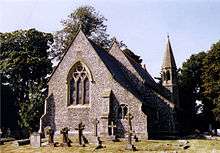 |
1852 | Thomas Talbot Bury, a pupil of Augustus Charles Pugin, designed the church in Gothic Revival style. At the west end is an octagonal spire. The reredos was carved by John Bacon, the son of the first parish priest.[143][144] | II |
| St Catherine Kingsdown |
Kent 51°17′39″N 0°45′36″E / 51.2943°N 0.7600°E |
 |
1865 | This is the only complete Anglican church to have been designed by E. W. Pugin, and it has remained virtually unaltered since. In a niche above the main doorway is a sculpture of Saint Catherine, and over the vestry door is a sculpture of the Conversion of Saint Paul. All the fittings and furniture were designed by Pugin, including the stained glass, which was made by Hardman.[145][146][147] | II |
| St Mary Itchen Stoke |
Hampshire 51°05′18″N 1°12′11″W / 51.0884°N 1.2031°W |
 |
1866 | The church was designed by Henry Conybeare, the brother of its rector, in French Gothic style, and was based on La Sainte-Chapelle in Paris. Along the sides of the church are four sets of three tall lancet windows, and at the west end is a rose window. The interior is highly decorated, with a painted roof, a tiled floor, a font inlaid with different types of marble, and brightly coloured stained glass in the windows.[148][149][150] | II* |
| Holy Trinity Privett |
Hampshire 51°02′17″N 1°02′10″W / 51.0381°N 1.0362°W |
 |
1876–78 | Funded by the gin distiller William Nicholson, the church was designed by Sir Arthur Blomfield, and has not been altered since. It is in Early English Gothic Revival style. On the tall tower is a broach spire with lucarnes. The internal walls are constructed in Ham stone with bands of Bath Stone, and the church is floored with marble mosaic.[151][152] | II* |
See also
For lists of churches preserved by the Churches Conservation Trust in other regions see:
Notes
A The dates given for construction are often not exactly known. Where this is the case the century of first construction of the existing building is given.
References
- 1 2 3 About us, Churches Conservation Trust, retrieved 15 October 2016
- ↑ Pastoral Measure 1983:Section 44(4), National Archives, 1983, retrieved 1 April 2011 (Pastoral Measure 1983 consolidates Pastoral Measure 1968 with later legislation.)
- ↑ Churches Conservation Trust, Charity Commission for England and Wales, retrieved 20 December 2010
- ↑ Board of Trustees, Churches Conservation Trust, retrieved 15 October 2016
- ↑ Listed Buildings, Historic England, retrieved 28 March 2015
- ↑ St Botolph's Church, Botolphs, West Sussex, Churches Conservation Trust, retrieved 15 October 2016
- ↑ Historic England, "Church of St Botolph, Bramber Botolphs (1191927)", National Heritage List for England, retrieved 28 March 2015
- ↑ All Saints' Church, West Stourmouth, Kent, Churches Conservation Trust, retrieved 15 October 2016
- ↑ Historic England, "Church of All Saints, Stourmouth (1203363)", National Heritage List for England, retrieved 28 March 2015
- ↑ Church of St Peter & St Paul, Albury, Surrey, Churches Conservation Trust, retrieved 15 October 2016
- ↑ Historic England, "The Old Parish Church of St Peter and St Paul, Albury (1294958)", National Heritage List for England, retrieved 28 March 2015
- ↑ The Saxon Church of St Peter and St Paul, The Parish of Albury, Surrey, retrieved 13 May 2011
- ↑ St Thomas' Church, East Shefford, Berkshire, Churches Conservation Trust, retrieved 15 October 2016
- ↑ Historic England, "The Old Church, Great Shefford (1321841)", National Heritage List for England, retrieved 28 March 2015
- ↑ Page, William; Ditchfield, P. H., eds. (1945), "Parishes: East Shefford or Little Shefford", A History of the County of Berkshire, Victoria County History, University of London & History of Parliament Trust, 4, pp. 234–238, retrieved 13 May 2011
- ↑ Baxter, Ron (2008), St Thomas, East Shefford, Berkshire, Corpus of Romanesque Sculpture of Great Britain and Ireland, retrieved 13 May 2011
- ↑ St Mary's Church, Higham, Kent, Churches Conservation Trust, retrieved 15 October 2016
- ↑ Historic England, "Church of St Mary, Higham (1321841)", National Heritage List for England, retrieved 28 March 2015
- ↑ A Profile of St Mary's Church, Higham, Higham Village History Group, retrieved 14 May 2011
- ↑ All Saints' Church, Little Somborne, Hampshire, Churches Conservation Trust, retrieved 15 October 2016
- ↑ Historic England, "All Saints Church, Little Somborne (1167714)", National Heritage List for England, retrieved 28 March 2015
- ↑ Page, William, ed. (1911), "Parishes: Little Sombourne", A History of the County of Hampshire, Victoria County History, University of London & History of Parliament Trust, 4, pp. 480–482, retrieved 14 May 2011
- ↑ Church of St Mary the Virgin, North Stoke, West Sussex, Churches Conservation Trust, retrieved 15 October 2016
- ↑ Historic England, "North Stoke Church, Amberley (1286953)", National Heritage List for England, retrieved 28 March 2015
- ↑ Lewis, Caroline (11 December 2007), Mystery of Sussex Church Solved by Archaeology Students, Culture24 (Arts Council England, Museums, Libraries and Archives Council and Department for Education), retrieved 14 May 2011
- ↑ Nairn, Ian; Pevsner, Nikolaus (1965), Sussex, The Buildings of England, Harmondsworth: Penguin Books, p. 283, ISBN 0-14-071028-0
- ↑ Pé, Diana (2008), West Sussex Church Walks (2 ed.), PP (Pé Publishing), p. 130, ISBN 0-9543690-0-9
- ↑ St Mary's Church, Sandwich, Kent, Churches Conservation Trust, retrieved 15 October 2016
- ↑ Historic England, "St Mary's Church, Sandwich (1069541)", National Heritage List for England, retrieved 28 March 2015
- ↑ St. Mary's Church, Sandwich History Society, retrieved 14 May 2011
- ↑ St. Mary's Venue, Sandwich St. Mary's Community Trust, retrieved 14 May 2011
- ↑ All Saints' Church, Shirburn, Oxfordshire, Churches Conservation Trust, retrieved 15 October 2016
- ↑ Historic England, "Former Church of All Saints, Shirburn (1284215)", National Heritage List for England, retrieved 28 March 2015
- ↑ St Mary's Church, Ashley, Hampshire, Churches Conservation Trust, retrieved 15 October 2016
- ↑ Historic England, "Church of St Mary, Ashley (1339063)", National Heritage List for England, retrieved 28 March 2015
- ↑ St Benedict's Church, Paddlesworth, Kent, Churches Conservation Trust, retrieved 15 October 2016
- ↑ Historic England, "Church of St Benedict, Snodland (1363120)", National Heritage List for England, retrieved 28 March 2015
- ↑ St Mary's Church, Burham, Kent, Churches Conservation Trust, retrieved 15 October 2016
- ↑ Historic England, "Church of St Mary the Virgin, Burham (1070523)", National Heritage List for England, retrieved 28 March 2015
- ↑ St Mary's Church, Capel-le-Ferne, Kent, Churches Conservation Trust, retrieved 15 October 2016
- ↑ Historic England, "Church of St Mary, Capel le Ferne (1070047)", National Heritage List for England, retrieved 28 March 2015
- ↑ St Margaret's Church, Catmore, Berkshire, Churches Conservation Trust, retrieved 15 October 2016
- ↑ Historic England, "Church of St Margaret, Catmore (1210997)", National Heritage List for England, retrieved 28 March 2015
- ↑ Pevsner, Nikolaus (1975), Berkshire, The Buildings of England, Harmondsworth: Penguin Books, p. 110, ISBN 0-14-071030-2
- ↑ Lumley Chapel (St Dunstan's), Cheam, Surrey, Churches Conservation Trust, retrieved 15 October 2016
- ↑ Historic England, "Remains of Old Church of St Dunstan, Now known as the Lumley Chapel, Sutton (1183440)", National Heritage List for England, retrieved 28 March 2015
- ↑ The Lumley Chapel, London Borough of Sutton, retrieved 14 May 2011
- ↑ Malden, H. E., ed. (1912), "Parishes: Cheam", A History of the County of Surrey, Victoria County History, University of London & History of Parliament Trust, 4, pp. 194–199, retrieved 14 May 2011
- ↑ Church of St Peter ad Vincula, Colemore, Hampshire, Churches Conservation Trust, retrieved 15 October 2016
- ↑ Historic England, "Church of St Peter ad Vincula, Colemore (1237037)", National Heritage List for England, retrieved 28 March 2015
- ↑ Church of St Peter ad Vincula, Colemore, Colemore Church, retrieved 14 May 2011 (The information in this source is based on brochures and guidebooks published by the Churches Conservation Trust)
- ↑ St Michael's Church, East Peckham, Kent, Churches Conservation Trust, retrieved 15 October 2016
- ↑ Historic England, "Church of St Michael, East Peckham (1363012)", National Heritage List for England, retrieved 28 March 2015
- ↑ St Mary's Church, Fleet Marston, Buckinghamshire, Churches Conservation Trust, retrieved 15 October 2016
- ↑ Historic England, "Church of St Mary, Fleet Marston (1117838)", National Heritage List for England, retrieved 28 March 2015
- ↑ Oxford: Home of the "first rise" of Methodism, Methodist Recorder Online, retrieved 15 May 2011
- ↑ Church of St Mary the Virgin, Fordwich, Kent, Churches Conservation Trust, retrieved 15 October 2016
- ↑ Historic England, "Church of St Mary, Fordwich (1063709)", National Heritage List for England, retrieved 28 March 2015
- ↑ St Mary's Church, Fordwich, Kent: A walk round guide (PDF), Churches Conservation Trust, retrieved 15 May 2011
- ↑ St Bartholemew's Church, Goodnestone, Kent, Churches Conservation Trust, retrieved 15 October 2016
- ↑ Historic England, "Church of St Bartholomew, Goodnestone (1069144)", National Heritage List for England, retrieved 28 March 2015
- ↑ St Mary's Church, Luddenham, Kent, Churches Conservation Trust, retrieved 15 October 2016
- ↑ Historic England, "Church of St Mary, Luddenham (1069094)", National Heritage List for England, retrieved 28 March 2015
- ↑ Church of St John the Baptist, Mongewell, Oxfordshire, Churches Conservation Trust, retrieved 15 October 2016
- ↑ Historic England, "Former Church of St John the Baptist, Crowmarsh (1059580)", National Heritage List for England, retrieved 28 March 2015
- ↑ St Mary's Church, Newnham Murren, Oxfordshire, Churches Conservation Trust, retrieved 15 October 2016
- ↑ Historic England, "Church of St Mary, Crowmarsh (1285860)", National Heritage List for England, retrieved 28 March 2015
- ↑ St Mary the Virgin Old Church, Preston Candover, Hampshire, Churches Conservation Trust, retrieved 15 October 2016
- ↑ Historic England, "Remains of the Church of St Mary, Preston Candover (1092852)", National Heritage List for England, retrieved 28 March 2015
- ↑ Church of St Mary Magdelene, Tortington, West Sussex, Churches Conservation Trust, retrieved 15 October 2016
- ↑ Historic England, "The Parish Church of Mary Magdalene, Arundel (1222209)", National Heritage List for England, retrieved 28 March 2015
- ↑ All Saints' Church, Waldershare, Kent, Churches Conservation Trust, retrieved 15 October 2016
- ↑ Historic England, "Church of All Saints, Tilmanstone (1247812)", National Heritage List for England, retrieved 28 March 2015
- ↑ Naumann, David; Marsh, Gill (30 April 2003), The Church of All Saints, Waldershare (PDF), Diocese of Canterbury, retrieved 16 May 2011
- ↑ Church of St John the Baptist, Upper Eldon, Hampshire, Churches Conservation Trust, retrieved 15 October 2016
- ↑ Historic England, "Church of St John the Baptist, Kings Somborne (1093786)", National Heritage List for England, retrieved 28 March 2015
- ↑ The Church of St John the Baptist, Upper Eldon, King's Somborne, Redundant Churches Fund, retrieved 16 May 2011
- ↑ St Andrew's Church, Kingsbury, London, Churches Conservation Trust, retrieved 15 October 2016
- ↑ Historic England, "Old Parish Church of St Andrew, Wembley (1188676)", National Heritage List for England, retrieved 28 March 2015
- ↑ Baker, T. F. T.; Pugh, R. B., eds. (1976), "Kingsbury: Churches", A History of the County of Middlesex, Victoria County History, University of London & History of Parliament Trust, 5, pp. 83–86, retrieved 17 May 2011
- ↑ St Giles', Merston, West Sussex, Churches Conservation Trust, retrieved 15 October 2016
- ↑ Historic England, "Church of St Giles, Merston (1276899)", National Heritage List for England, retrieved 28 March 2015
- ↑ Merston - St Giles, Sussex Parish Churches, retrieved 12 March 2015
- ↑ Church of St Thomas a Becket, Capel, Kent, Churches Conservation Trust, retrieved 15 October 2016
- ↑ Historic England, "Church of St Thomas à Becket, Capel (1262867)", National Heritage List for England, retrieved 28 March 2015
- ↑ St Thomas à Becket, Capel, Tudeley cum Capel with Five Oak Green parish, retrieved 17 May 2011
- ↑ St Wilfrid's Church, Church Norton, West Sussex, Churches Conservation Trust, retrieved 15 October 2016
- ↑ Historic England, "St Wilfrid's Chapel, Selsey (1026240)", National Heritage List for England, retrieved 28 March 2015
- ↑ St James' Church, Cooling, Kent, Churches Conservation Trust, retrieved 15 October 2016
- ↑ Historic England, "Church of St James, Cooling (1204117)", National Heritage List for England, retrieved 28 March 2015
- ↑ History of St James' Church, St James' Church, retrieved 17 May 2011
- ↑ St Mary's Church, Edlesborough, Buckinghamshire, Churches Conservation Trust, retrieved 15 October 2016
- ↑ Historic England, "Church of St Mary, Edlesborough (1117908)", National Heritage List for England, retrieved 28 March 2015
- ↑ St Nicholas' Church, Freefolk, Hampshire, Churches Conservation Trust, retrieved 15 October 2016
- ↑ Historic England, "Church of St Nicholas, Laverstoke (1092725)", National Heritage List for England, retrieved 28 March 2015
- ↑ St Mary's Church, Hartley Wintney, Hampshire, Churches Conservation Trust, retrieved 15 October 2016
- ↑ Historic England, "Church of St Mary, Hartley Wintney (1092270)", National Heritage List for England, retrieved 28 March 2015
- ↑ Page, William, ed. (1911), "Parishes: Hartley Wintney", A History of the County of Hampshire, Victoria County History, University of London & History of Parliament Trust, 4, pp. 79–81, retrieved 17 May 2011
- ↑ St Mary's Church, Pitstone, Buckinghamshire, Churches Conservation Trust, retrieved 15 October 2016
- ↑ Historic England, "Church of St Mary, Pitstone (1117829)", National Heritage List for England, retrieved 28 March 2015
- ↑ Page, William, ed. (1925), "Parishes: Pitstone", A History of the County of Buckingham, Victoria County History, University of London & History of Parliament Trust, 3, pp. 406–412, retrieved 17 May 2011
- ↑ St Peter's Church, Preston Park, East Sussex, Churches Conservation Trust, retrieved 15 October 2016
- ↑ Historic England, "Church of St Peter, Brighton (1380743)", National Heritage List for England, retrieved 28 March 2015
- ↑ St Peter's Church, Sandwich, Kent, Churches Conservation Trust, retrieved 15 October 2016
- ↑ Historic England, "Church of St Peter, Sandwich (1343813)", National Heritage List for England, retrieved 28 March 2015
- ↑ History, St Peter's Church, Sandwich, retrieved 18 May 2011
- ↑ St Peter's Church, Swingfield, Kent, Churches Conservation Trust, retrieved 15 October 2016
- ↑ Historic England, "Church of St Peter, Swingfield (1242414)", National Heritage List for England, retrieved 28 March 2015
- ↑ Church of The Holy Sepulchre, Warminghurst, West Sussex, Churches Conservation Trust, retrieved 15 October 2016
- ↑ Historic England, "Church of the Holy Sepulchre, Ashington (1027448)", National Heritage List for England, retrieved 28 March 2015
- ↑ Hudson, T. P., ed. (1986), "Warminghurst: Church", A History of the County of Sussex, Victoria County History, University of London & History of Parliament Trust, 6 (2), pp. 57–60, retrieved 18 May 2011
- ↑ St Bartholomew's Church, Lower Basildon, Berkshire, Churches Conservation Trust, retrieved 15 October 2016
- ↑ Historic England, "Church of St Batholomew, Basildon (1221092)", National Heritage List for England, retrieved 28 March 2015
- ↑ St Lawrence's Church, Broughton, Buckinghamshire, Churches Conservation Trust, retrieved 15 October 2016
- ↑ Historic England, "Church of St Lawrence, Broughton (1332313)", National Heritage List for England, retrieved 28 March 2015
- ↑ Church of St Michael & All Angels, Thornton, Buckinghamshire, Churches Conservation Trust, retrieved 15 October 2016
- ↑ Historic England, "Church of St Michael, Thornton (1232799)", National Heritage List for England, retrieved 28 March 2015
- ↑ Thornton Church, Wolverton & District Archaeological & Historical Society, retrieved 18 May 2011
- ↑ The Ruinous Grotto, Wolverton & District Archaeological & Historical Society, retrieved 18 May 2011
- ↑ St Clement's Church, Knowlton, Kent, Churches Conservation Trust, retrieved 15 October 2016
- ↑ Historic England, "Church of St Clement, Goodnestone (1111748)", National Heritage List for England, retrieved 28 March 2015
- ↑ St George's Church, Esher, Surrey, Churches Conservation Trust, retrieved 15 October 2016
- ↑ Historic England, "Church of St George, Esher (1030218)", National Heritage List for England, retrieved 28 March 2015
- ↑ History of St George's Church, Esher, St George's Church, Esher, retrieved 19 April 2011
- ↑ Chandos Mausoleum (St Lawrence's Church), Little Stanmore, London, Churches Conservation Trust, retrieved 15 October 2016
- ↑ Historic England, "Church of St Lawrence, Harrow (1194471)", National Heritage List for England, retrieved 28 March 2015
- ↑ Baker, T. F. T.; Pugh, R. B., eds. (1976), "Little Stanmore: Church", A History of the County of Middlesex, Victoria County History, University of London & History of Parliament Trust, 5, pp. 122–124, retrieved 18 May 2011
- ↑ Church of The Assumption, Hartwell, Buckinghamshire, Churches Conservation Trust, retrieved 15 October 2016
- ↑ Historic England, "Church of St Mary, Stone with Bishopstone and Hartwell (1160658)", National Heritage List for England, retrieved 28 March 2015
- ↑ Re-roofing a roofless ruin, Churches Conservation Trust, retrieved 19 May 2011
- ↑ St Katherine's Church, Chiselhampton, Oxfordshire, Churches Conservation Trust, retrieved 15 October 2016
- ↑ Historic England, "Church of St Katherine, Stadhampton (1193807)", National Heritage List for England, retrieved 28 March 2015
- ↑ St Peter's Church, Wallingford, Oxfordshire, Churches Conservation Trust, retrieved 15 October 2016
- ↑ Historic England, "Church of St Peter, Wallingford (1182891)", National Heritage List for England, retrieved 28 March 2015
- ↑ Music at St Peter's, Wallingford, Music at St Peter's, retrieved 19 May 2011
- ↑ All Saints' Church, Nuneham Courtenay, Oxfordshire, Churches Conservation Trust, retrieved 15 October 2016
- ↑ Historic England, "Church of All Saints, Nuneham Courtenay (1286134)", National Heritage List for England, retrieved 28 March 2015
- ↑ Lobel, Mary D., ed. (1957), "Parishes: Nuneham Courtenay", A History of the County of Oxford, Victoria County History, University of London & History of Parliament Trust, 5, pp. 234–249, retrieved 19 May 2011
- ↑ Church of St John the Evangelist, Chichester, West Sussex, Churches Conservation Trust, retrieved 15 October 2016
- ↑ Historic England, "Church of St John the Evangelist, Chichester (1026696)", National Heritage List for England, retrieved 28 March 2015
- ↑ St Andrew's Church, Hove, East Sussex, Churches Conservation Trust, retrieved 15 October 2016
- ↑ Historic England, "Church of St Andrew, Hove (1298653)", National Heritage List for England, retrieved 28 March 2015
- ↑ St Mary's Church, Lambourn Woodlands, Berkshire, Churches Conservation Trust, retrieved 15 October 2016
- ↑ Historic England, "Church of St Mary, Lambourne (1136089)", National Heritage List for England, retrieved 28 March 2015
- ↑ St Catherine's Church, Kingsdown, Kent, Churches Conservation Trust, retrieved 15 October 2016
- ↑ Historic England, "Church of St Catherine, Milstead and Kingsdown (1343953)", National Heritage List for England, retrieved 28 March 2015
- ↑ Booklet: Redundant Churches Fund, St. Catherine, Kingsdown, Kent, Lynsted with Kingsdown Society, retrieved 19 May 2011
- ↑ St Mary's Church, Itchen Stoke, Hampshire, Churches Conservation Trust, retrieved 15 October 2016
- ↑ Historic England, "Church of St Mary, Itchen Stoke And Ovington (1095286)", National Heritage List for England, retrieved 28 March 2015
- ↑ Sanderson, Isabel, The History of St Mary's Church, Itchen Stoke, Southern Life (UK), retrieved 19 May 2011
- ↑ Holy Trinity Church, Privett, Hampshire, Churches Conservation Trust, retrieved 15 October 2016
- ↑ Historic England, "Church of the Holy Trinity, Froxfield (1237168)", National Heritage List for England, retrieved 28 March 2015